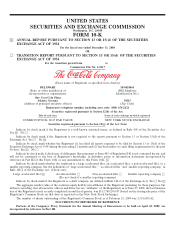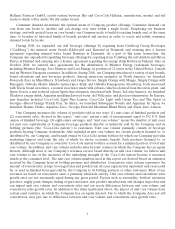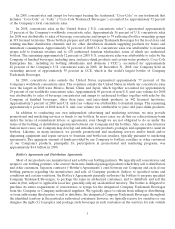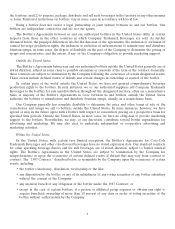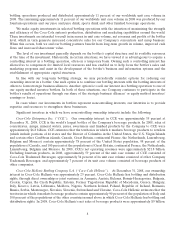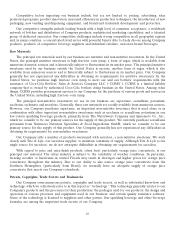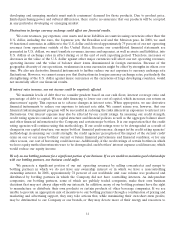Coca Cola 2008 Annual Report Download - page 6
Download and view the complete annual report
Please find page 6 of the 2008 Coca Cola annual report below. You can navigate through the pages in the report by either clicking on the pages listed below, or by using the keyword search tool below to find specific information within the annual report.Hellenic Partners GmbH, a joint venture between Ilko and Coca-Cola Hellenic, manufacture, market and sell
ready-to-drink coffee under the illy issimo brand.
Consumer demand determines the optimal menu of Company product offerings. Consumer demand can
vary from one locale to another and can change over time within a single locale. Employing our business
strategy, and with special focus on core brands, our Company seeks to build its existing brands and, at the same
time, to broaden its historical family of brands, products and services in order to create and satisfy consumer
demand locale by locale.
During 2008, we expanded our still beverage offerings by acquiring from Carlsberg Group Beverages
(‘‘Carlsberg’’) the mineral water brands Kildevaeld and Kurvand in Denmark and entering into a license
agreement regarding mineral water brand Ramlosa in Denmark. As a part of this same transaction, the
Company also expanded its sparkling beverage offerings by acquiring from Carlsberg the soft drink brand Hyvaa
Paivaa in Finland and entering into a license agreement regarding the energy drink Battery in Finland. Also, in
October 2008, we entered into agreements for the distribution of Monster Energy trademark beverages,
including Monster Energy, Java Monster and Lost Energy, in portions of 21 states in the United States, Canada
and six Western European countries. In addition, during 2008, our Company introduced a variety of new brands,
brand extensions and new beverage products. Among numerous examples, in North America, we launched
Powerade Zero in Mixed Berry, Strawberry and Grape flavors, Simply Orange with Mango, Simply Orange with
Pineapple, Odwalla Mojito Mambo natural juice drink and Odwalla Pomegranate Strawberry, both sweetened
with Truvia brand sweetener, a natural sweetener made with rebiana, which is derived from the stevia plant, and
Sprite Green, a new reduced calorie Sprite line extension, sweetened with Truvia. In Latin America, we launched
Gladiator energy drink, Aquarius sparkling flavored water, del Valle juice and glac´
eau vitaminwater. In Europe,
new launches included Coca-Cola Light Plus Lemon, Coca-Cola Light with Green Tea and The Spirit of
Georgia—Blood Orange Prickly Pear. In Africa, we launched Schweppes Novida and Aquarius. In Japan, we
launched Hajime Chaka, Aquarius Zero, Georgia Emerald Mountain Blend Black and Fanta Zero Lemon.
Our Company measures the volume of products sold in two ways: (1) unit cases of finished products and
(2) concentrate sales. As used in this report, ‘‘unit case’’ means a unit of measurement equal to 192 U.S. fluid
ounces of finished beverage (24 eight-ounce servings); and ‘‘unit case volume’’ means the number of unit cases
(or unit case equivalents) of Company beverage products directly or indirectly sold by the Company and its
bottling partners (the ‘‘Coca-Cola system’’) to customers. Unit case volume primarily consists of beverage
products bearing Company trademarks. Also included in unit case volume are certain products licensed to, or
distributed by, our Company, and brands owned by Coca-Cola system bottlers for which our Company provides
marketing support and from the sale of which we derive economic benefit. Such products licensed to, or
distributed by, our Company or owned by Coca-Cola system bottlers account for a minimal portion of total unit
case volume. In addition, unit case volume includes sales by joint ventures in which the Company has an equity
interest. Although most of our Company’s revenues are not based directly on unit case volume, we believe unit
case volume is one of the measures of the underlying strength of the Coca-Cola system because it measures
trends at the consumer level. The unit case volume numbers used in this report are derived based on estimates
received by the Company from its bottling partners and distributors. Concentrate sales volume represents the
amount of concentrates, syrups, beverage bases and powders (in all cases expressed in equivalent unit cases) sold
by, or used in finished beverages sold by, the Company to its bottling partners or other customers. Most of our
revenues are based on concentrate sales, a primarily wholesale activity. Unit case volume and concentrate sales
growth rates are not necessarily equal during any given period. Factors such as seasonality, bottlers’ inventory
practices, supply point changes, timing of price increases, new product introductions and changes in product mix
can impact unit case volume and concentrate sales and can create differences between unit case volume and
concentrate sales growth rates. In addition to the items mentioned above, the impact of unit case volume from
certain joint ventures, in which the Company has an equity interest, but to which the Company does not sell
concentrates, may give rise to differences between unit case volume and concentrate sales growth rates.
4

